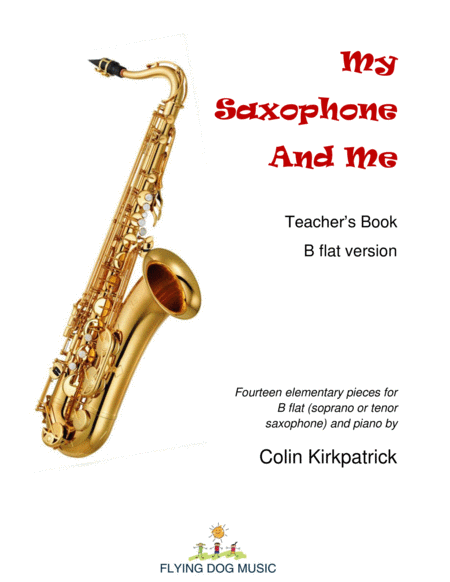Piano,Tenor Saxophone - Level 1 - Digital Download SKU: A0.522193 Composed by Colin Kirkpatrick. Contemporary,Instructional,Standards. Score and part. 28 pages. Colin Kirkpatrick Publications #3133717. Published by Colin Kirkpatrick Publications (A0.522193). My Saxophone and Me consists of fourteen short and delightful pieces written especially for absolute beginners up to students at elementary level. The book comes in two versions, one for B flat saxophones and the other for E flat instruments. However, for obvious reasons you cannot mix B flat and E flat instruments in the same group. The pieces are intended as supplementary material to your usual tutor books. The music can be used with any number of players and the pieces remain in the lower register. Several early pieces use only the notes B, A and G and the key of G major predominates. Six of the pieces use only half notes (minims) and quarter notes (crotchets). The low C, a tricky note for some beginners, has been avoided almost completely. On the one occasion it appears, the note C an octave above is given as optional. Although the pieces are arranged in approximate order of difficulty you can play them in any order you want, depending on the musical needs of the student. Your students are sure to enjoy these pieces, which are both easy on the fingers and easy on the ear! Several pieces have a few measures (bars) rest in the middle not only to give the player a break and add musical contrast but also to give the experience of counting empty bars during the music. When space allows, piano cues appear in the solo part. Some of the later pieces in the book have good performing potential and could be strung together in any order to create a small suite. Every piece has a short piano introduction so that the student can sense the tempo and musical style before playing. The keyboard accompaniments have been kept as simple as possible with the minimum number of notes. Dynamic markings (e.g. piano and mezzo-forte) are used from the start, but phrasing has been omitted from the solo part. This is because the teacher is usually in the best position to suggest phrasing within the physical capabilities of each student. Slurs have been employed sparingly and only when necessary. An MP3 file of all the piano accompaniments is also available as a separate item. You can find it here: https://www.sheetmusicplus.com/title/20679835 The book includes a well-known folk lullaby from Wales and a lively folk song from Thailand which is known by all Thai people because itâs taught in elementary schools throughout the country. The music has been converted into pdf files at 1,200 dpi which will produce professional looking printed copies of high quality. However, the output quality will also depend on your own printer settings and capabilities. The publication consists of a teacher's book (18 pages) and a student's book (8 pages) both contained in the same pdf file. The sample MP3 (click on the âListenâ button above) contains recordings of Starting Tune (No 1); Island Song (No 3); Waltzing Around (No 7); Just a Minuet (No 11) and Donkey Trot (No 12). Colin Kirkpatrick studied at Londonâs Royal College of Music. He followed a career in music education. He was a High School Music Director in London for about fifteen years and later became a Music Education Adviser for local government, with responsibility for training teachers and directing the instrumental teaching service. The work in education gave him many opportunities for composing. He has published a great deal of music and his publishers include Boosey & Hawkes, Novello, Paxton, Schott, Oxford University Press, Chester, Belwin Mills and Intrada (Netherlands). His music has been performed and broadcast all over Europe as well as in Japan, Thailand, Australia and the USA. He holds MA and PhD degrees. He was a High School Music Director for about fifteen years and then became a Music Education Adviser for local government, with the added responsibility for training teachers and overseeing the instrumental service. He has written.
